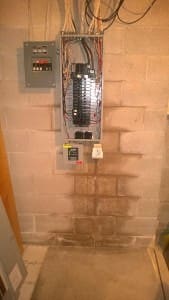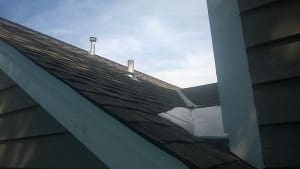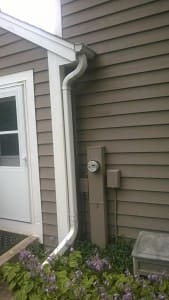Diagnosing gutter and water problems can be complex.
Maryann from Cedarburg was at a loss; unable to figure out what was causing water to cascade over her gutter and come through her basement walls.
THE CHALLENGE:
Her challenges can be solved, but it’s going to take some changes and an understanding of why the problem is occurring. First, a small piece of gutter (18 inches) must accommodate a large amount of water since there are two facets of their roof that spill into just the one small gutter. During heavy water water events, a high volume of rain water shoots down the valley of the roof, effectively acting as a water cannon.
The design of her home makes it so that there is no feasible way to minimize water that shoots into this one concentrated area. One valley in the roof shoots onto metal pan flashing. Due to some poor architectural design the flashing is the best way to reduce changes for water to get into the house. Notice in the photo how there is only about 24 inches from the bottom of the pan flashing, to the gable end of the roof. In heavy rains, a large volume of water will continue along the pan flashing and in the worse case scenario, spill right over the gable end of the house and drop to the ground, putting her house at risk for more water coming into the basement.

Low capacity gutter protection used in an area that only a high capacity gutter protection should be used.
Even the water that does make it to her small gutter, isn’t guaranteed to make it into the gutter. The cookie cutter approach would be to blame the size of the gutter or simply upsize the downspout. To make matters worse, the small gutter is covered with a low capacity gutter protection system to reduce clog potential from leaves. However, if over half of the gutter entry point is obstructed, the water will cascade over the top of the gutter, onto the ground, and into the basement.
THE SOLUTION:
1) Eliminate or replace the low capacity gutter protection that is preventing high volumes of water from coming into the basement.
2) Add an additional extender to the bottom of the gutter. Low cost plastic extenders can be acquired from nearly any Ace Hardware store or Tru-Value hardware store for about $7. When houses are built, builders often dig an extra foot or two away from the house. This area is then backfilled with either stone or whatever soil is accessible.
3) This homeowner is seeking to control costs and the most effective way to keep the water flowing is by using a gutter strainer which is a high gauge metal mesh that allows water to get into the downspout even if leaves get into the gutter.
4) A diverter can be installed onto the roof. This is a bent piece of metal that when water wants to shoot down the valley in the roof, will force the water to hit the diverter shield and drop straight into the gutter.
5) If those issues don’t solve the problem, the homeowner needs to look at landscaping options. One of the first things to look at it is the pitch of the ground surrounding the house as well as soil types. You always want the water to flow away from the house. Many homeowners simply add topsoil next to their house without understanding that the role of topsoil plays in our ecosystem is to act as an organic material great for growing plants, but not good for repelling water. Think of top soil as a sponge material which is to say that water will drop straight through it. If you’re looking to get water to flow away from your house, you should use clay and slope it. If you like, you can put an inch or two of topsoil over the clay in order to plant grass.




